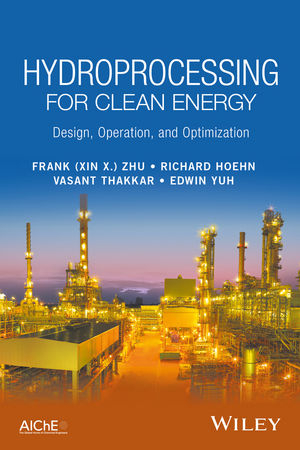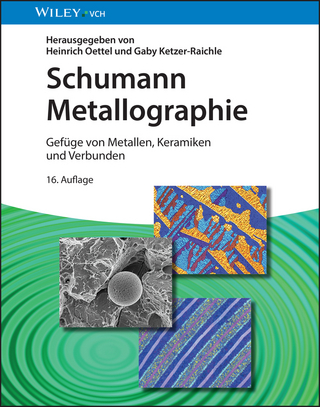
Hydroprocessing for Clean Energy
Wiley-AIChE (Verlag)
978-1-118-92135-7 (ISBN)
- Titel z.Zt. nicht lieferbar
- Versandkostenfrei innerhalb Deutschlands
- Auch auf Rechnung
- Verfügbarkeit in der Filiale vor Ort prüfen
- Artikel merken
Provides a holistic approach that looks at changing process conditions, possible process design changes, and process technology upgrades
Includes process integration techniques for improving process designs and for applying optimization techniques for improving operations focusing on hydroprocessing units.
Discusses in details all important aspects of hydroprocessing – including catalytic materials, reaction mechanism, as well as process design, operation and control, troubleshooting and optimization
Methods and tools are introduced that have a successful application track record at UOP and many industrial plants in recent years
Includes relevant calculations/software/technologies hosted online for purchasers of the book
Frank Zhu, PhD, is Senior Fellow at Honeywell UOP, Des Plaines. He is a leading expert in industrial process design, modeling and energy optimization with more than 80 publications and 30 patents. He is the co-founder of the ECI International Conference: CO2 Summit, the recipient of AIChE Energy and Sustainability Award, and the author of Energy and Process Optimization for the Process Industries by Wiley/AICHE. Richard Hoehn is a Senior Fellow at Honeywell UOP, Des Plaines where he has been employed for 42 years, 31 of which have been in the field of hydroprocessing. He received a BS in chemical engineering from Purdue University. He currently holds 36 US patents and has received the Ernest W. Thiele Award from the Chicago Section of the AIChE. Dr. Vasant Thakkar, PhD, was a Senior Fellow at Honeywell UOP, Des Plaines, before retiring in 2015. Vasant worked in Refining R&D Group for over 36 years. Vasant received Honeywell Distinguished Technologist award in 2014. Vasant holds 38 US patents. He received Ph. D. in chemical Engineering from Colorado school of Mine. He held membership in AIChE and ASTM D2 committee. Edwin Yuh is a Fellow at Honeywell UOP, Des Plaines where he has been employed for 37 years, 35 of which have been in the field of hydroprocessing. He received a BS in chemical engineering from Columbia University and a MS in chemical engineering from Northwestern University. Most of his UOP career is in technical service.
Preface xiii
Part 1 Fundamentals 1
1 Overview of This Book 3
1.1 Energy Sustainability 3
1.2 ULSD – Important Part of the Energy Mix 4
1.3 Technical Challenges for Making ULSD 7
1.4 What is the Book Written for 8
References 8
2 Refinery Feeds Products and Processes 9
2.1 Introduction 9
2.2 ASTM Standard for Crude Characterization 10
2.3 Important Terminologies in Crude Characterization 12
2.4 Refining Processes 13
2.5 Products and Properties 15
2.6 Biofuel 20
3 Diesel Hydrotreating Process 23
3.1 Why Diesel Hydrotreating? 23
3.2 Basic Process Flowsheeting 25
3.3 Feeds 28
3.4 Products 30
3.5 Reaction Mechanisms 36
3.6 Hydrotreating Catalysts 40
3.7 Key Process Conditions 44
3.8 Different Types of Process Designs 47
References 48
4 Description of Hydrocracking Process 51
4.1 Why Hydrocracking 51
4.2 Basic Processing Blocks 53
4.3 Feeds 58
4.4 Products 59
4.5 Reaction Mechanism and Catalysts 61
4.6 Catalysts 67
4.7 Key Process Conditions 70
4.8 Typical Process Designs 75
References 78
Part 2 Hydroprocessing Design 79
5 Process Design Considerations 81
5.1 Introduction 81
5.2 Reactor Design 81
5.3 Recycle Gas Purity 98
5.4 Wash Water 102
5.5 Separator Design 107
5.6 Makeup Gas Compression 115
References 121
6 Distillate Hydrotreating Unit Design 123
6.1 Introduction 123
6.2 Number of Separators 123
6.3 Stripper Design 127
6.4 Debutanizer Design 135
6.5 Integrated Design 136
References 147
7 Hydrocracking Unit Design 149
7.1 Introduction 149
7.2 Single-stage Hydrocracking Reactor Section 150
7.3 Two-stage Hydrocracking Reactor Section 155
7.4 Use of a Hot Separator in Hydrocracking Unit Design 158
7.5 Use of Flash Drums 160
7.6 Hydrocracking Unit Fractionation Section Design 161
7.7 Fractionator First Flow Scheme 161
7.8 Debutanizer First Flow Scheme 163
7.9 Stripper First Fractionation Flow Scheme 166
7.10 Dual Zone Stripper Fractionation Flow Scheme 168
7.11 Dual Zone Stripper – Dual Fractionator Flow Scheme 170
7.12 Hot Separator Operating Temperature 171
7.13 Hydrogen Recovery 174
7.14 LPG Recovery 175
7.15 HPNA Rejection 177
7.16 Hydrocracking Unit Integrated Design 181
References 187
Part 3 Energy and Process Integration 189
8 Heat Integration for Better Energy Efficiency 191
8.1 Introduction 191
8.2 Energy Targeting 191
8.3 Grassroots Heat Exchanger Network (Hen) Design 202
8.4 Network Pinch for Energy Retrofit 206
Nomenclature 213
References 213
9 Process Integration for Low-Cost Design 215
9.1 Introduction 215
9.2 Definition of Process Integration 216
9.3 Grand Composite Curves (GCC) 218
9.4 Appropriate Placement Principle for Process Changes 219
9.5 Dividing Wall Distillation Column 225
9.6 Systematic Approach for Process Integration 228
9.7 Applications of the Process Integration Methodology 230
9.8 Summary of Potential Energy Efficiency Improvements 246
References 247
10 Distillation Column Operating Window 249
10.1 Introduction 249
10.2 What is Distillation? 249
10.3 Why Distillation is the Most Widely Used? 251
10.4 Distillation Efficiency 253
10.5 Definition of Feasible Operating Window 255
10.6 Understanding Operating Window 256
10.7 Typical Capacity Limits 275
10.8 Effects of Design Parameters 275
10.9 Design Checklist 278
10.10 Example Calculations for Developing Operating Window 281
10.11 Concluding Remarks 296
Nomenclature 297
References 299
Part 4 Process Equipment Assessment 301
11 Fired Heater Assessment 303
11.1 Introduction 303
11.2 Fired Heater Design for High Reliability 304
11.3 Fired Heater Operation for High Reliability 310
11.4 Efficient Fired Heater Operation 315
11.5 Fired Heater Revamp 321
Nomenclature 322
References 322
12 Pump Assessment 323
12.1 Introduction 323
12.2 Understanding Pump Head 324
12.3 Define Pump Head – Bernoulli Equation 325
12.4 Calculate Pump Head 329
12.5 Total Head Calculation Examples 330
12.6 Pump System Characteristics – System Curve 332
12.7 Pump Characteristics – Pump Curve 333
12.8 Best Efficiency Point (BEP) 338
12.9 Pump Curves for Different Pump Arrangement 338
12.10 Npsh 340
12.11 Spillback 345
12.12 Reliability Operating Envelope (ROE) 346
12.13 Pump Control 347
12.14 Pump Selection and Sizing 347
Nomenclature 351
References 351
13 Compressor Assessment 353
13.1 Introduction 353
13.2 Types of Compressors 354
13.3 Impeller Configurations 357
13.4 Type of Blades 358
13.5 How a Compressor Works 358
13.6 Fundamentals of Centrifugal Compressors 360
13.7 Performance Curves 362
13.8 Partial Load Control 364
13.9 Inlet Throttle Valve 366
13.10 Process Context for a Centrifugal Compressor 367
13.11 Compressor Selection 368
Nomenclature 369
References 369
14 Heat Exchanger Assessment 371
14.1 Introduction 371
14.2 Basic Concepts and Calculations 371
14.3 Understand Performance Criterion – U Values 374
14.4 Understand Fouling 380
14.5 Understand Pressure Drop 382
14.6 Effects of Velocity on Heat Transfer Pressure Drop and Fouling 384
14.7 Heat Exchanger Rating Assessment 385
14.8 Improving Heat Exchanger Performance 396
Nomenclature 399
References 400
15 Distillation Column Assessment 401
15.1 Introduction 401
15.2 Define a Base Case 401
15.3 Calculations for Missing and Incomplete Data 403
15.4 Building Process Simulation 406
15.5 Heat and Material Balance Assessment 408
15.6 Tower Efficiency Assessment 411
15.7 Operating Profile Assessment 414
15.8 Tower Rating Assessment 417
15.9 Guidelines 419
Nomenclature 420
References 420
Part 5 Process System Evaluation 423
16 Energy Benchmarking 425
16.1 Introduction 425
16.2 Definition of Energy Intensity for a Process 426
16.3 The Concept of Fuel Equivalent for Steam and Power (FE) 427
16.4 Data Extraction 429
16.5 Convert All Energy Usage to Fuel Equivalent 432
16.6 Energy Balance 432
16.7 Fuel Equivalent for Steam and Power 435
16.8 Energy Performance Index (EPI) Method for Energy Benchmarking 441
16.9 Concluding Remarks 444
16.10 Nomenclature 445
References 446
17 Key Indicators and Targets 447
17.1 Introduction 447
17.2 Key Indicators Represent Operation Opportunities 448
17.3 Define Key Indicators 451
17.4 Set Up Targets for Key Indicators 456
17.5 Economic Evaluation for Key Indicators 460
17.6 Application 1: Implementing Key Indicators into an “Energy Dashboard” 463
17.7 Application 2: Implementing Key Indicators to Controllers 465
17.8 It is Worth the Effort 466
Nomenclature 467
References 467
18 Distillation System Optimization 469
18.1 Introduction 469
18.2 Tower Optimization Basics 470
18.3 Energy Optimization for Distillation System 475
18.4 Overall Process Optimization 481
18.5 Concluding Remarks 489
References 490
Part 6 Operational Guidelines and Troubleshooting 491
19 Common Operating Issues 493
19.1 Introduction 493
19.2 Catalyst Activation Problems 494
19.3 Feedstock Variations and Contaminants 495
19.4 Operation Upsets 496
19.5 Treating/Cracking Catalyst Deactivation Imbalance 497
19.6 Flow Maldistribution 500
19.7 Temperature Excursion 501
19.8 Reactor Pressure Drop 504
19.9 Corrosion 506
19.10 Hpna 509
19.11 Conclusion 511
20 Troubleshooting Case Analysis 513
20.1 Introduction 513
20.2 Case Study I – Product Selectivity Changes 514
20.3 Case Study II – Feedstock Changes 516
20.4 Case Study III – Catalyst Deactivation Balance 523
20.5 Case Study IV – Catalyst Migration 526
20.6 Conclusion 536
Index 537
| Sprache | englisch |
|---|---|
| Maße | 160 x 239 mm |
| Gewicht | 975 g |
| Themenwelt | Naturwissenschaften ► Chemie |
| Technik ► Elektrotechnik / Energietechnik | |
| Technik ► Maschinenbau | |
| ISBN-10 | 1-118-92135-6 / 1118921356 |
| ISBN-13 | 978-1-118-92135-7 / 9781118921357 |
| Zustand | Neuware |
| Informationen gemäß Produktsicherheitsverordnung (GPSR) | |
| Haben Sie eine Frage zum Produkt? |
aus dem Bereich


